The van Eyck Project
The van Eyck Project originated with a commission by David Rumsey for the Netherlands organ builder, Winold van der Putten, to build a reconstruction of a gothic organ based in part on contemporary iconography, but mainly on musical and metallurgical studies as well as van der Putten’s considerable prior experience in this rare and highly specialized arena.
David Rumsey’s dedicated mediæval pages
Details of the Rumsey-van der Putten organ
Survey of organ pipe technologies and related matters
The van Eyck painting of 1432, that of the van der Goes in Edinburgh and the drawings of the Peterborough Psalter were among the main iconographical sources, while the Robertsbridge, Faenza and Buxheim codices were central to the repertoire investigations.
Examples of some of the iconography taken into consideration
Built in 2010 the organ has since toured extensively and been repeatedly used with singers and instrumental ensembles throughout most of central Europe. It was never intended to be a copy of the organ depicted in the Ghent altarpiece or the painting in Scotland, although it has all their essential characteristics. In fact the original Ghent picture was later painted over, so that neither pipes nor keys shown now are photographically-reliable but represent a modernized concept of the instrument from about a century later.
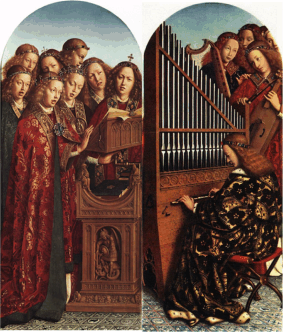
More importantly, the Ghent altarpiece depicts a very particular musical ensemble. This became the focal point and major programming determinant for a concert and presentation in Muri (Aargau, Switzerland) in June 2014. In this instance, what was based on the painting were the two separate groups of musicians, one of singers and one of instrumentalists, and the apparent division between the vocal and instrumental ensembles. It seems clear that the organist plays with the singers while the other instrumentalists wait (the fiddle player checking the tuning). And as in most iconography from the time, the singers read from music while the instrumentalists did not. This was therefore a springboard for exploring the concept of instruments as improvising their repertoire or playing ornamented versions of (presumably) memorised songs, while the singers keep to a relatively plain text. This can be done in many different ways – solos and varied ensemble scoring – but the underlying principle is the same.
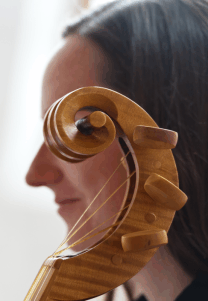
The painting presents 8 singers and at least 5 instrumentalists. The Muri ensemble was a reduction of this to the minimum: 3 singers (enough to cover each vocal line), and the 3 visible instruments (organ, fiddle and bray harp). A variant of this with at least the full number of singers is certainly planned for the future as part of the continuing van Eyck Project; this will presumably show a different side to the balance and tone colour questions.
The musicians involved in the Muri presentation have known each other and worked together for a long period of time; they are all specialists in mediæval and Renaissance polyphony as well as keyboard music or chant. The Muri presentation broke new ground in being centred around both the organ and the van Eyck ensemble.
The Light of prior Experience
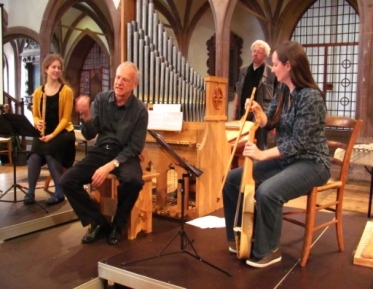
Tobie Miller, David Rumsey, Winold van der Putten, Elizabeth Rumsey
6' rank in front, “Arnaut”-scaled rank behind
From 2010 through 2013, in the lead-up to the 2014 Muri presentation, the Rumsey/van der Putten organ had already illuminated and clarified many aspects of properly recreating mediæval music within the parameters of its own era. While forcing players into what might at first seem to be somewhat restricted playing options, within a short time it then points them quickly to a wider palette of different performance techniques. This opens many doors to mediæval music-making not otherwise generally available. Of particular importance is the special tonal quality produced by lead pipes, their striking effects in ensemble usage and the manner in which this guides singers and instrumentalists in their performances.
To respect the natural tonal beauty of the pipes and known mediæval construction methods, chest design was kept small and simple. Having split keys, many stops, or encouraging changes to be made from one moment to the next, were anachronous and unacceptable. Thus they were severely restricted or avoided altogether. With three ranks and only two sliders on a windchest, specification change takes time when e.g. the 6' Arnaut de Zwolle rank is exchanged for the constant-scaled 8' rank - around 15-20 minutes with pre-trained personnel (optimally 2-3 people). This is naturally more feasible from one performance situation to the next than within a single presentation but certainly precludes anachronous stop-changes from one moment to the next.
For tempering changes, pipes must be removed and replaced. This obliges the player to make well-thought-through tempering decisions beforehand or adapt the music on the spot or choose to accept tempering clangers as (quite possibly) part of an acceptable mediæval soundscape. Tempering change can be quicker, but is also largely impractical within the confines of one performance (unless a break is built into the program as it was in Sissach in 2013). Thus, while choices can easily enough be predefined, there is no easy means of quick change in the course of a contiguous performance, especially in concerts.
The lack of anachronistic and visually disturbing tuning slides also forbids micro adjustments on the fly to tuning or tempering, common with some modern mediæval performances. Pythagorean tuning offers a number of alternatives within the system and the provision of separate pipes which can be exchanged, e.g. for C# and D♭ or other “black keys”, allows the instrument to offer the wolf in several places. For details see the 2013 Amsterdam post-conference comments: a complete summary of this is given under the Tempering subheading.
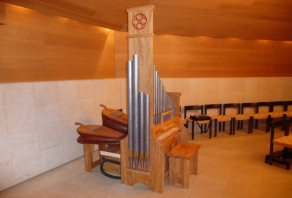
The organ, especially its keyboard compass, was largely designed around the requirements of the Robertsbridge Codex (c1320), Faenza Codex (c1430) and Buxheimer Orgelbuch (c1455). There are many ways in which the instrument channels players into correct mediæval performance practices - not least being the key-widths with, e.g. their effect on fingering, but wind quality and action characteristics are also very much part of this. The use of forge bellows (no ribs or bellows shears, just two “old windbags”) are here mission-critical. The choice between an outboard electric blower and a calcant has demonstrated the clear superiority of the latter and at times led to creative uses where player and calcant become “two brothers of concordant spirit” (to misapply Wulstan's 10th century poem about the Winchester organ). Some very creative, also modern 21st century uses - especially in flexibility of bellows manipulation - have been found by performers such as Christoph Delignes (in Amsterdam, June 2013) and Catalina Vicens.
Arnaut de Zwolle’s 15th century scaling principles for the main 8' and 6' ranks have their own interlocking integrity with this. The Anonymous of Berne 11th century manuscript’s “width of a pigeon’s egg” pipe-scaling for a constant-scaled rank gives musical perspectives of unique and exceptional value. The largest known egg-size was slightly exceeded on the basis of published scholarly observations and our own research. This shows that the scaling practices of the Berne Anonymous grew to wider diameters in later centuries. Physical pitch limitations from pipes of the chosen diameter (c27mm) soon became clear, using known mediæval pipe construction and voicing methods. They also brought the instrument’s dynamics into a clear and genuine mediæval focus, especially important when accompanying voices and instruments emulating other known mediæval parameters.

In what has become its more standard configurations (Wolf b-g♭ or g♯-e♭, Arnautde Zwolle and constant-scaled 8' ranks installed) players have sensed a remarkably easy affinity with most 15th century music, and an encouragement to improvisation and ornamentation, notably the Buchner mordent. This is again well-supported by the scaling and voicing of the 8' ranks and the use of lead, known for centuries as enabling agile successions of notes, especially in the treble range. The option of the 6' in place of the constant-scaled 8' rank allows a glimpse of some earlier than 14th century music that apparently used inseparable 8' + 6' registrations, although to go back to 14th century or earlier music increasingly forces the issue of copper rather than lead pipes and pre-Arnaut scaling practices. Any 8' and 6' combination seems destined for not much later than about the watershed era of copper-to-lead. The quinty 8'+6' combination conjures up strong rejection with some listeners whilst others find immediate acceptance, for example in the Robertsbridge repertoire. This was most notable at a conference of specialists at Amsterdam in June 2013.
Some additional comments on the Amsterdam Symposium
The constant-scaled 8' rank opens up many an interesting issue, especially with Robertsbridge, to which it seems well suited, although arguably marginally too narrow-scaled. This is an important and most welcome problem: it forces pitch considerations through transposition and experimentation. The most suitable pitch for a constant-scaled rank will naturally be different depending on the scaling and piece chosen. However, lead pipes with “pigeon’s egg” constant scaling used in the second Robertsbridge Estampie seem to be in excellent symbiosis here with an A=520 Hz pitch (i.e. transposed up a tone on this instrument). At a=466 Hz (the normal pitch of the organ) the lower notes are on the verge of becoming troublesome and require arguably anachronistic ears on the pipes to make them speak quickly enough. Transposed a tone higher, this scaling moves the music up in pitch and avoids a troublesome two or three bass notes, at the same time producing a marvellous bloom in the treble parts. Where three parts exist it presents each part in a subtly different colour (bass “stringy”, mid-range “principally”, trebles “flutey”). Transposed a tone higher still this seemingly magical effect is not quite so evident and anything higher or lower than the above-mentioned transpositions (effectively performance pitches) range from useless to somewhat bland.
The distinctive tone and rather special carrying power of lead pipes, open-toe regulation, 42mm natural wind pressure from the gothic-style bellows, the pipe scaling and voicing at the mouth has impressed players, singers and instrumentalists as well as audiences. It is a fresh and gentle sound with a remarkable tonal focus and solidity. Most notable is perhaps the constant-scaled rank with its stringy basses and flutey trebles which also bring ancient musical forms - such as Redeuntes - startlingly to life. These qualities have also been found to serve the ensemble music of this era exceptionally well. The instrument has its own special excellence in ensembles, and has become a preferred instrument for many groups, e.g. for Jankees Braaksma’s ensemble Super Librum.
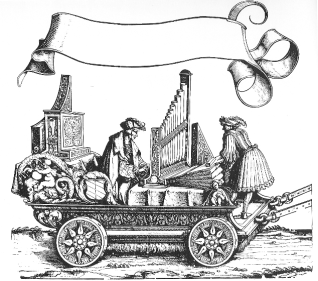
(anon.16th century; Hofhaymer playing?)
The difficulties in moving an organ of this size and weight around - between the ease of carrying portatives and impossibility of carting large Blockwerks - increases our respect and understanding for such depictions as the horse- or camel-drawn wagons in the Triumphal Procession of Maximilian etchings. If this is accurate imagery then we might well be impressed by those who had to move and secure these instruments. Most importantly in that connection are questions of tuning stability under such conditions, or alternatively, mediæval tolerance of out-of-tuneness. In fact the experience of moving this organ around, through a whole range of unsympathetic climatic and other variables, including particularly vicious Netherlands drempels (speed humps), has demonstrated that tuning stability of an exceptionally high order is available from these thick-walled, lead pipes without tuning slides. The sheer mass of lead and wood has offered special challenges, but the instrument can be moved and played without any significant retuning being required.
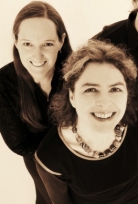
The Muri Programme
With the many valuable experiences garnered in previous international performances, the afternoon held at Muri on June 9th 2014, which went under the banner of “Die Orgel im Herbst des Mittelalters” (“The Organ in the Autumn of the Middle Ages”), continued, confirmed, endorsed and enhanced these. This was the first of the dedicated van Eyck projects focusing specifically on the resources - vocal, instrumental, organ - represented by the famous Ghent painting.
Full details of the van Eyck Project part of the Muri June 9th 2014 program
Some recorded excerpts from the concert are available:
✥ In tua memoria (Arnold de Lantins) Play recording (.mp3) [Three voices, organ, bray harp, fiddle 3'58"]
✥ O florens rosa mater Christi (Anon. Buxheimer Orgelbuch, c1450) Play recording (.mp3) [Organ 1'22"]
✥ Craindre vous vueil (Guillaume Dufay) Play recording (.mp3) [Vocal ensemble 4'54"]
✥ Ave maris stella (Anon. Codex Faenza c1410) Play recording (.mp3) [Chant - Organ 2'06"]
✥ O intemerata virginitas (Anon. Buxheimer Orgelbuch) Play recording (.mp3) [Bray harp, fiddle, organ 3'00"]
✥ Rorate celi desuper et nubes pluant (Anon. Buxheimer Orgelbuch) Play recording (.mp3) [Organ 3'43"]
The van Eyck Project in Muri: entertainment value?
It was an interesting experience to present essentially liturgical music as a structured concert program. This is a long-recognised problem - for example from the mid-20th century’s rediscovery of Palestrina when everything from Kyrie to Agnus was sometimes presented wall to wall in a concert. Liturgical music is generally constructed with gaps for articulate speech (prayers, sermons) or silence (moments of meditation, reflection). It is a music of spirituality and symbolism and the degree to which it was entertainment was carefully controlled by an ever-suspicious church. The comparison with stage or film music is clear and, as with those genres, the music does not always work well simply played outside its proper setting.
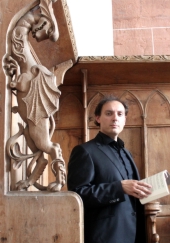
However, the Muri concert, of mainly sacred music, needed to be presented and accepted as entertainment, at least of the Concert Spirituel genus. To the dedicated and educated audience who attended, this was understood and certainly caused no problems. An important principle was followed in its planning: the program was designed in relatively short contrasting segments so that the missing spoken or still moments of the liturgy were compensated for by good musical textural contrasts. The bray harp was very important here.
Playing the action: controlling pipe speech
The narrower the pipe-scaling, the slower bass pipes are to speak. Yet they do respond, even when played at what seems like demandingly fast tempi. Lead has long been known, not only for its sweetness of tone, but also for its agility and promptness of speech. The pipes themselves, largely by virtue of their open toe voicing, have a fresh, naturally therapeutic sound. There may be more to that than initial scrutiny might suggest. Chiff - along with pipe power and tone, is not so easy to regulate with open-toe voicing - virtually the only means of adjustment are the upper lip, lower lip and languid. However, as with the unavoidable irregularities of hand-blowing using forge-bellows, small irregularities add interest and charm to the music; the lack of total perfection here can become an intriguing enhancement to the musical perception of the playing.
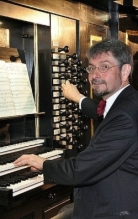
The emphasis on the tenor line of vocal models is customarily subverted in keyboard intabulations of the late 15th century in favour of a florid upper part, where divisions drawn from contemporary fundamenta organizandi and a grace probably performed by the simultaneous use of the middle and index fingers (the murdentes later described by the Hofhaimer pupil Hans Buchner) are employed. It should also be noted that old German letter tablature precludes the notation of the latter in the lower voices. Constant-scaled pipes allow treble ornaments to be the most rapid and clear, slower-speaking bass pipes increasingly discourage ornamentation in the bass octaves. This explains the high preponderance of treble ornaments.
Tempering questions - lupus quo vadis?
Major thirds have little importance in the music theory of the middle ages, where the term ditone is preferred. With the advent of Arnaut de Zwolle's Pythagorean tuning scheme, in which the impure fifth (schisma) is located between b♮ and g♭, composers were able to experiment with major triads on a, d and e, where both the fifth and the major third are “good”. These frequently appear at cadence points and their musical effect must be weighed against any occurrence of the impure fifth in the musical fabric. (Although the schisma can theoretically be moved anywhere in the cycle of fifths, it was probably most often located between g♯ and e♭ in music prior to about 1440; as frequently-used as it now is, this is nevertheless a claim based on modern speculation, experience and repertoire analysis and not clearly found in any original source).

In the preparation for the Muri concert some doubts were expressed as to the suitability of the Arnaut scheme being used for the ensemble pieces. Accordingly the constant-scaled rank was given the alternative g♯-e♭ wolf as an option. Brett Leighton’s choice of “Arnaut tempering” (wolf b-g♭) for all but one of the solo pieces was, in the final analysis, empirical (preparation for the concert included a trial and assessment of both schemes). Placement of the sour fifth affects the placement of all the notes within the octave, which in turn gives a particular colour to the different modes. It is possible that our perception of these is still conditioned more by a modern musical upbringing than by any thorough understanding of mediæval aesthetics. However many others are now also working on these aspects - for example Mark Lindley and Adam B. Rahbee in the USA.
Brett Leighton commented afterwards: “it was a luxury we had on June 7th and, from my point of view, totally successful. The virtues of Pythagorean tuning, which is non-cyclical, are its simplicity to set and its documented use for the music of this time. This doesn't mean that it was used randomly or unreflectedly as a matter of course. Musicians in the middle ages had aesthetic reasons for employing it in whichever form.”
Voicing, scaling and tonal qualities of mediæval pipework
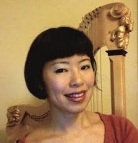
The sound of the Rumsey/van der Putten instrument is clearly perceived as something special by audiences. It tends to encourage listener attention - and evident pleasure, judging by facial expressions - as its natural beauty unfolds in the course of being played. On the other hand, with only three different registrations available (two if the tempering is different between front and rear ranks, as it was at Muri) only limited tonal variety is available. That was the case with most mediæval organs until the era of stop-separation. So it is the organist who must create the interest by varying touch, articulation and phrasing to utilize the uniqueness of parameters not normally available in modern organs. This tends to encourage practices such as alternatim (where the organ is contrasted with other musical textures or human speech or simply silence) or using the ensemble to provide tonal variety and interest rather than registration.
The three main mediæval organ types were the Blockwerk, Positive and Portative. For alternatim work all three could be used, although a portative could rapidly prove unsatisfactory in that context. For accompanying, and in ensemble, an unseparated Blockwerk could be overwhelming if large (not all were), whereas the other two would be more equal contenders. The missing bass range of a Portative was its limitation, so, under normal conditions, the Positive would be the best suited to ensembles with instruments and voices. The iconography tends to confirm this. This is one aspect of the Rumsey/van der Putten organ where it seems to have been born to succeed exceptionally convincingly.
Instruments and instrumental ensemble balance
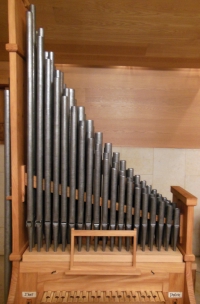
The Arnaut de Zwolle and the constant-scaled ranks all get flutier towards the top, the constant-scaled rank more obviously; conversely, its bass range is far less full in tone. The middle range of either gives the most Diapason/Principal-like tone. As such there is a clear pitch focus in this range, producing tonal strengths which equal those of most contemporary instruments, but, interestingly, never seem to compete with them. It is in the top ranges, where the flutiness switches in, that there is a reduction in harmonic strength and content which allows what is being accompanied to be better audible without loss of an underlying supporting dynamic. For example, in situations where recorders are being accompanied this style of scaling and voicing works remarkably well and causes none of the problems of modern organs where, mostly, Principals are too strong and Flutes tonally too similar to the recorder.
Voices and vocal balance
In Muri the singers at first found themselves a little pushed by the tonal qualities of the pipework. But they soon became used to it and started to work effectively at the dynamic levels it demanded.
The same can be said for the balance of the instruments. It would take a large number of other instruments to match the dynamic power of the organ, but the tonal colour allows the sound of at least the fiddle and bray harp to come through and provide a pleasing contrast in tone when all play together.

Acknowledgements
The van Eyck Project would like to acknowledge the work of Johannes Strobl, organist and music director in Muri. It was his drive and one of his many dedicated initiatives that provided the “mediæval Saturday afternoon” on 9th June 2014, at which the van Eyck Project concert was pleased to make its contribution.
The event was held under the auspices of Murikultur to whom our gratitude is also extended.
✥ ✥ ✥
Musicians of the van Eyck Project
Sabine Lutzenberger Web-Site of the Ensemble "Per Sonat"
Giovanni Cantarini Web-Site of Giovanni Cantarini
Achim Schulz Web-Site of Achim Schulz
Masako Art Web-Site of Masako Art
Elizabeth Rumsey Web-Site of the Ensemble "Le Miroir de Musique"
Brett Leighton Wikipedia
✥ ✥ ✥
Some further Links:
David Rumsey’s mediæval organ page - includes a mini-glossary of mediæval organ terms, definitions of mediæval organ types, a brief survey of mediæval organ culture as well as details and recordings of a concert in Weil-am-Rhein (Germany) on Sunday 18th March 2012 with Ensemble Musica Practica, Basel - including excerpts from the Mass setting Nunca fué pena mayor by Francisco de Peñalosa (ca. 1470-1528).
Featured also are numerous recordings and demonstration-movies e.g. on YouTube with Jankees Braaksma and much more.
✥ ✥ ✥
Compiled by David Rumsey, Brett Leighton and Elizabeth Rumsey
✥ ✥ ✥